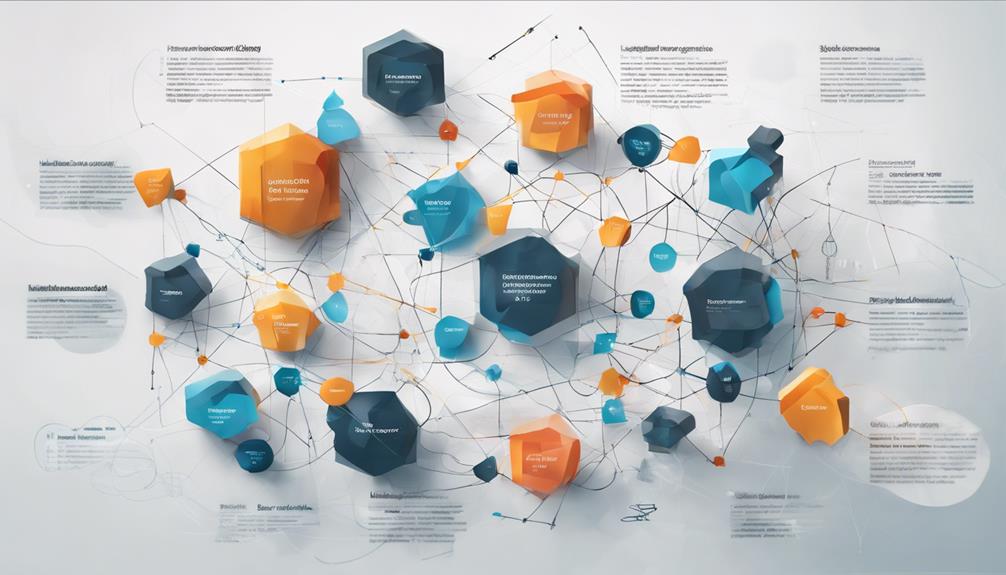Understanding Concentric Mergers in Mergers and Acquisitions

Concentric mergers happen when companies in the same industry join forces to create synergies and expand their market reach. These mergers are aimed at boosting market share, reaching new customer segments, and improving financial performance by pooling resources and technology.
Examples of such mergers include the merger of Kraft-Heinz and Citi's acquisition of Travelers. The main advantages of concentric mergers include increased market presence, a broader range of products and services, and a strengthened competitive position. However, challenges may arise in merging corporate cultures and aligning operations.
It is crucial to assess the potential for synergy and the impact on diversification when considering concentric merger opportunities. Exploring the intricacies of this strategic approach can offer valuable insights for businesses navigating the intricate landscape of mergers and acquisitions.
Key Takeaways
Concentric mergers occur when companies within the same industry join forces to create synergies, broaden their product offerings, and increase their market share. The main goal of concentric mergers is to leverage their existing strengths, explore new growth prospects, and improve their financial performance by pooling resources together.
Some well-known examples of concentric mergers include the merger between Kraft and Heinz, Coca-Cola's acquisition of Vitamin Water, and PepsiCo's purchases of Gatorade and Tropicana Juice. These mergers have allowed the companies involved to strengthen their market presence, offer a wider range of products and services, and gain a stronger competitive edge in their respective markets.
The success of concentric mergers hinges on the careful evaluation of potential synergies between the merging companies, the assessment of product compatibility, and the development of a comprehensive integration strategy. By strategically aligning their operations and resources, companies engaging in concentric mergers can unlock greater value and drive sustainable growth in the long run.
What Are Concentric Mergers?
Concentric mergers occur when companies in the same industry come together to create synergies and expand their range of products and services. These mergers are aimed at increasing market share, diversifying offerings, and reaching new customer segments.
By pooling resources such as technology, marketing strategies, and distribution channels, the merged companies can benefit each other and strengthen their position in the industry.
Successful examples like the merger between Citi and Travelers illustrate how concentric mergers can improve a company's market presence and customer offerings. Another noteworthy instance is the $100 billion merger between Heinz and Kraft, highlighting the potential for concentric mergers to drive industry consolidation and revenue growth.
As the landscape of mergers and acquisitions evolves, concentric mergers are expected to play a crucial role in helping companies leverage their core strengths, explore new markets, and provide increased value to their customers. This strategic approach to growth is becoming increasingly popular among industry leaders seeking to stay competitive and expand their reach.
How Do Concentric Mergers Differ?

Concentric mergers set themselves apart from horizontal, vertical, and conglomerate mergers by focusing on expanding market share and product offerings within the same industry. Rather than diversifying across industries or streamlining their supply chain, companies opt for concentric mergers to tap into new customer bases and enhance financial performance through the sharing of technology and distribution channels.
Take, for instance, the merger between Heinz and Kraft in 2015, a deal worth $100 billion that catapulted the combined entity into a dominant position in the food industry. By blending complementary product lines and distribution networks, the merger unlocked new growth opportunities.
Similarly, Citi's acquisition of Travelers enabled the company to bolster its suite of financial services, while Coke's acquisition of Vitamin Water broadened its beverage offerings.
What distinguishes concentric mergers from other merger strategies is their emphasis on market diversification and synergies within a single industry. By strategically selecting compatible partners, companies can leverage their existing strengths to drive innovation and capitalize on unexplored prospects that mightn't be accessible through horizontal or vertical integrations.
Reasons for Concentric Mergers

Generally, companies pursue concentric mergers to capitalize on their existing strengths and explore new growth opportunities within their industry. By joining forces with businesses in similar or related markets, they aim to expand their market share and enhance their range of products. This strategic move allows them to reach a broader customer base and boost their financial performance through synergies.
One primary motivation for opting for concentric mergers is the opportunity to access innovative technology and shared distribution channels for mutual advantage. Through the combination of resources and expertise, companies can strengthen their presence in the market and offer customers a more competitive and diverse set of products and services.
Successful instances like Citi's merger with Travelers and Coke's acquisition of Vitamin Water highlight the benefits of product diversification and synergy in driving growth and fostering innovation.
Ultimately, the objective behind concentric mergers is to reinforce the company's position in the industry and provide customers with a more extensive and valuable range of offerings. This strategic approach enables companies to stay ahead of the competition and meet the changing demands of their target market effectively.
Prominent Examples of Concentric Mergers

Numerous well-known mergers have exemplified the strategic benefits of concentric combinations in various industries. One notable example is the merger between Citi and Travelers in 1998, which created a financial powerhouse by combining banking and insurance services. This merger allowed the newly formed entity to offer a wider range of financial products and services to its customers, increasing its competitive edge in the market.
Similarly, Coca-Cola's acquisition of Vitamin Water in 2007 highlighted the synergies that can be achieved through a concentric merger in the beverage industry. By integrating Vitamin Water's popular product line with its own distribution network, Coca-Cola was able to expand its market reach and diversify its product portfolio.
In the technology sector, the merger between Nextlink and Concentric Network Corp in 1999 showcased the advantages of sharing technology and expertise in a concentric merger. This collaboration not only enhanced the companies' technological capabilities but also allowed them to offer more comprehensive solutions to their customers.
Concentric mergers, such as PepsiCo's acquisitions of Gatorade and Tropicana Juice, have proven to be successful in enhancing market presence and product offerings. By integrating these well-known brands into its portfolio, PepsiCo was able to strengthen its position in the beverage industry and cater to a broader range of consumer preferences.
The Kraft-Heinz merger in 2015, valued at $100 billion, illustrated the effectiveness of concentric mergers in the food industry. With complementary product lines that catered to different market segments, the merger enabled the newly formed entity to achieve cost savings, streamline operations, and capitalize on cross-selling opportunities.
These prominent examples underscore the strategic rationale behind concentric mergers, where companies leverage their shared resources and capabilities to create value, enhance their competitive position, and drive growth in their respective industries.
The Biggest Concentric Merger in History

The merger between Heinz and Kraft in 2015, with a whopping value of $100 billion, stands out as the largest concentric merger in history. This merger exemplifies the potential of strategic partnerships between businesses with complementary strengths. The creation of Kraft-Heinz through this monumental deal positioned the company as a significant player in the food industry, well-positioned to leverage the synergies of their product offerings.
The success of Heinz-Kraft merger post-integration can be attributed to the harmonious blend of their non-competing yet complementary product lines. By pooling their resources and market presence, the merged entity was able to drive substantial revenue growth, solidifying its role as a key industry consolidator. This consolidation highlights the value that concentric mergers bring in enhancing overall competitiveness and market influence.
The Heinz-Kraft merger serves as a prime example of how strategic thinking in mergers and acquisitions can lead to exponential growth and value creation. By recognizing and capitalizing on the strengths of each company, businesses can unlock new opportunities that would have been challenging to achieve through organic growth alone.
This historic merger underscores the significance of concentric mergers in reshaping industries and driving sustainable growth.
Advantages of Concentric Mergers

By leveraging their collective industry expertise, concentric mergers enable companies to diversify their product portfolios and expand their customer base within their primary markets. Through the consolidation of resources and capabilities, organizations can take advantage of economies of scale and synergies in shared technology, marketing strategies, and distribution channels.
This strategic amalgamation facilitates an enhanced market presence and the ability to offer a wider range of products and services to customers.
Concentric mergers offer a unique opportunity to drive financial growth by tapping into new customer segments and bolstering competitive advantage. The seamless collaboration between merging entities allows for the development of innovative solutions that cater more effectively to the changing needs of the market.
Sharing best practices and leveraging complementary strengths leads to operational efficiencies and creates new pathways for business expansion.
Successful instances like Citi's acquisition of Travelers illustrate the transformative potential of concentric mergers in reshaping industries and generating lasting value for stakeholders. Embracing this strategic approach positions organizations for sustained success in a dynamic business environment, setting the stage for continued growth and prosperity.
Disadvantages of Concentric Mergers

While concentric mergers can offer strategic advantages, it's crucial to consider the potential drawbacks they may entail. One significant challenge is the integration of different corporate cultures and management styles from the merging companies. This can lead to conflicts and difficulties in aligning the organizations' values and ways of working, potentially hampering the post-merger integration process.
Moreover, the complexity of merging similar product lines in concentric mergers can result in redundant efforts and resource allocation. This duplication of tasks and resources can lead to inefficiencies and confusion within the newly formed entity, impacting its overall performance and competitiveness in the market.
Additionally, when concentric mergers lead to overlapping operations and functions, it can create power struggles and challenges in decision-making processes. Balancing the interests and responsibilities of the leadership teams from both merging entities can be a delicate task, potentially causing disruptions and hindering the effective functioning of the combined organization.
Furthermore, the increased competition resulting from concentric mergers can lead to market saturation, making it challenging for the merged entity to differentiate itself and stand out in a crowded marketplace. This can impact profitability and market share, requiring strategic initiatives to reposition the company and regain its competitive edge.
To address these disadvantages effectively, organizations undertaking concentric mergers need to develop a well-thought-out integration strategy. This strategy should focus on clear communication, cultural alignment, and operational optimization to maximize the benefits of the merger while mitigating potential challenges.
Evaluating Concentric Merger Opportunities

When looking at concentric merger opportunities, it's crucial to start by examining the potential synergies in technology, marketing, and distribution. By blending these elements, companies can enhance their overall competitiveness and market reach.
Moreover, considering the implications of diversification is key. Merging with complementary products can pave the way for accessing new customer bases and gaining a strategic edge over competitors.
In essence, a comprehensive evaluation of these critical aspects will be pivotal in determining the feasibility and lasting success of any concentric merger.
Synergy Potential Analysis
When analyzing the synergy potential in a concentric merger, it's crucial to consider how the blending of technologies, marketing strategies, and distribution channels can create added value for the merged entity.
Identifying products and services that complement each other and have the potential to reach new markets is key. Understanding the overlap in customer base and exploring opportunities for cross-selling can boost revenue streams and enhance customer satisfaction.
Finding ways to cut costs by sharing resources and improving operational efficiencies is a vital aspect of determining the financial advantages of a concentric merger. It's also important to assess how the merger can help increase market share, gain competitive edges, and enhance the range of products offered.
Diversification Implications
Concentric mergers offer more than just expanding product and service offerings within the same industry. They allow us to combine strengths to enhance our competitive position and reach a wider customer base.
Here's how it works:
- Technology, marketing, and distribution synergy: When we merge with a company in a similar industry, we can leverage shared technology, marketing strategies, and distribution channels. This synergy creates a powerful impact on our market presence and customer appeal.
- Economies of scale and risk reduction: Through a concentric merger, we can achieve economies of scale and reduce the risks associated with focusing on a single product or service. This diversification empowers us to seize new growth opportunities.
- Expanded customer reach and market share: By considering concentric merger opportunities, we can assess how the merger will contribute to our market share growth and enable us to reach a broader customer base. This strengthens our position in the industry.
Key Considerations for Concentric Mergers

When considering a concentric merger, it's crucial to carefully assess the potential synergies and cost savings that can be realized. Evaluating how combining different but related businesses can create a more efficient and profitable entity is essential.
Moreover, exploring the opportunities for market expansion that arise from merging complementary customer bases and distribution channels is key.
Analyzing these critical factors helps determine if a concentric merger aligns with our strategic objectives and adds value for our stakeholders. By focusing on the potential benefits of combining businesses that operate in related industries, we can make informed decisions that drive growth and success.
Synergies and Cost Savings
In concentric mergers, our primary focus revolves around synergies and cost savings to enhance the competitiveness and profitability of the combined entity. By tapping into shared industry knowledge and resources, we aim to achieve economies of scale and drive operational efficiency. This approach enables us to streamline our product offerings, expand our market share, and ultimately increase overall profitability.
To maximize the benefits of these mergers, we concentrate on three key areas:
- Integrating technology, marketing strategies, and distribution channels to establish smooth operations and eliminate any unnecessary duplications.
- Optimizing resource utilization by merging overlapping functions and assets, resulting in significant cost reductions.
- Leveraging synergies to bolster the market position and competitiveness of the combined company, ultimately paving the way for long-term growth and success.
Through this strategic focus, we're confident in our ability to deliver added value for our stakeholders and carve out a strong presence in the industry.
Market Expansion Opportunities
Concentric mergers offer a strategic opportunity to expand our market presence and diversify our product offerings within the same industry. By leveraging our existing strengths and resources, we can effectively target new customer segments and enhance our competitive edge.
Through concentric mergers, we can gain access to advanced technology, innovative marketing strategies, and efficient distribution channels. This access allows us to achieve cost savings, streamline operations, and ultimately boost our profitability. Notable cases like Disney's acquisition of Pixar demonstrate how such mergers can significantly increase market influence and create value for customers.
To capitalize on concentric merger opportunities, it's crucial to carefully evaluate potential synergies, assess product compatibility, and develop a comprehensive integration strategy. By executing these mergers thoughtfully, we can unlock new avenues for growth and reinforce our position as industry frontrunners.
Frequently Asked Questions
What Are Concentric Mergers?
Concentric mergers involve companies combining their strengths in the same industry to increase efficiency, expand their market reach, and enhance their technological capabilities. By tapping into industry synergies, these mergers help companies diversify their offerings and improve the overall customer experience by streamlining their supply chains.
What Are the Disadvantages of Congeneric Mergers?
Oh, those 'innovative' mergers that supposedly bring so much 'benefit'? Sure, we have synergies galore – if only we could streamline our 20 different pricing strategies and 8 separate supply chains. Understanding each other's culture? That seems to be a foreign concept.
Concentric mergers, which involve companies in related industries merging together, often face challenges in integrating their operations smoothly. While they may share some similarities in terms of products or services, the differences in their approaches, strategies, and cultures can create significant obstacles.
Research shows that companies engaging in concentric mergers may struggle with aligning their business models and organizational structures. This can lead to confusion among employees, duplication of efforts, and inefficiencies in decision-making processes.
Furthermore, the lack of a clear strategic direction and vision post-merger can result in a loss of focus and competitive advantage. Without a well-defined plan for how the merged entities will work together towards common goals, the potential benefits of the merger may not be fully realized.
What Is the Purpose of a Congeneric Merger?
We engage in concentric mergers to enhance our core competencies, streamline operations, and strengthen our market position. By aligning ourselves with companies that offer related products or services, we can leverage our existing knowledge and resources to drive growth and increase our competitive advantage.
Concentric mergers allow us to capitalize on our expertise in a specific industry or market segment, enabling us to better serve our customers and respond to changing market trends. This strategic approach also helps us to diversify our product offerings and reach new customer segments, ultimately expanding our market reach and driving revenue growth.
Through concentric mergers, we aim to create a more cohesive and integrated organization, where the synergies between our businesses can be maximized to drive efficiency and innovation. By combining our technologies, supply chains, and talent pools, we can optimize our operations and create new opportunities for growth and expansion.
What Are the Four Types of Mergers and Acquisitions?
Horizontal, vertical, conglomerate, and concentric – these are the four main types of mergers and acquisitions that companies engage in. While horizontal mergers involve companies that operate in the same industry and are direct competitors, vertical mergers occur between companies in the same supply chain but at different stages of production. Conglomerate mergers, on the other hand, involve companies that are in unrelated industries, aiming to diversify their offerings.
Concentric mergers, also known as related diversification, involve companies that are in related industries and have similar customers, but do not directly compete with each other. This type of merger allows companies to expand their product offerings and reach a broader customer base while still leveraging their existing resources and expertise.
Concentric mergers can lead to synergistic effects by combining the strengths of both companies, such as shared distribution channels or complementary products. By joining forces through a concentric merger, companies can achieve economies of scale, reduce costs, and increase their market share. This type of merger is seen as a strategic move to enhance competitiveness and drive growth in a rapidly changing business environment.
Conclusion
Concentric mergers offer distinct strategic benefits. Yet, it's crucial to also acknowledge their potential downsides. By conducting a thorough assessment of the specific circumstances and synergies at play, we can determine whether a concentric merger is the most suitable direction for our organization.
The success of any merger fundamentally relies on aligning the cultures, operations, and long-term goals of the merging entities. This alignment ensures a smooth integration that maximizes value for all stakeholders.





